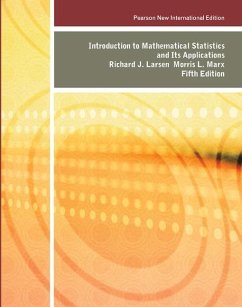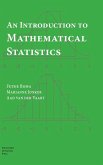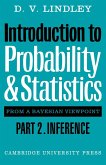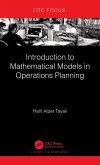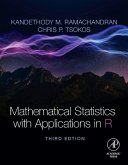- Broschiertes Buch
- Merkliste
- Auf die Merkliste
- Bewerten Bewerten
- Teilen
- Produkt teilen
- Produkterinnerung
- Produkterinnerung
Noted for its integration of real-world data and case studies, this text offers sound coverage of the theoretical aspects of mathematical statistics. The authors demonstrate how and when to use statistical methods, while reinforcing the calculus that students have mastered in previous courses. Throughout the Fifth Edition, the authors have added and updated examples and case studies, while also refining existing features that show a clear path from theory to practice.
Andere Kunden interessierten sich auch für
![John E. Freund's Mathematical Statistics with Applications John E. Freund's Mathematical Statistics with Applications]() Irwin MillerJohn E. Freund's Mathematical Statistics with Applications114,99 €
Irwin MillerJohn E. Freund's Mathematical Statistics with Applications114,99 €![An Introduction to Mathematical Statistics An Introduction to Mathematical Statistics]() Fetsje BijmaAn Introduction to Mathematical Statistics48,99 €
Fetsje BijmaAn Introduction to Mathematical Statistics48,99 €![Probability and Statistics Probability and Statistics]() Morris DeGrootProbability and Statistics116,99 €
Morris DeGrootProbability and Statistics116,99 €![Introduction to Probability and Statistics from a Bayesian Viewpoint, Part 2, Inference Introduction to Probability and Statistics from a Bayesian Viewpoint, Part 2, Inference]() D. V. LindleyIntroduction to Probability and Statistics from a Bayesian Viewpoint, Part 2, Inference47,99 €
D. V. LindleyIntroduction to Probability and Statistics from a Bayesian Viewpoint, Part 2, Inference47,99 €![Introduction to Mathematical Models in Operations Planning Introduction to Mathematical Models in Operations Planning]() Halit Alper TayaliIntroduction to Mathematical Models in Operations Planning59,99 €
Halit Alper TayaliIntroduction to Mathematical Models in Operations Planning59,99 €![Mathematical Statistics with Applications in R Mathematical Statistics with Applications in R]() Kandethody M. Ramachandran (Professor of Mathematics and StatisticsMathematical Statistics with Applications in R128,99 €
Kandethody M. Ramachandran (Professor of Mathematics and StatisticsMathematical Statistics with Applications in R128,99 €![An Introduction To Experimental Design And Statistics For Biology An Introduction To Experimental Design And Statistics For Biology]() David HeathAn Introduction To Experimental Design And Statistics For Biology131,99 €
David HeathAn Introduction To Experimental Design And Statistics For Biology131,99 €-
-
-
Noted for its integration of real-world data and case studies, this text offers sound coverage of the theoretical aspects of mathematical statistics. The authors demonstrate how and when to use statistical methods, while reinforcing the calculus that students have mastered in previous courses. Throughout the Fifth Edition, the authors have added and updated examples and case studies, while also refining existing features that show a clear path from theory to practice.
Produktdetails
- Produktdetails
- Verlag: Pearson Education Limited
- 5 ed
- Seitenzahl: 744
- Erscheinungstermin: 29. Juli 2013
- Englisch
- Abmessung: 276mm x 216mm x 40mm
- Gewicht: 1642g
- ISBN-13: 9781292023557
- ISBN-10: 1292023554
- Artikelnr.: 48933514
- Herstellerkennzeichnung
- Pearson
- St.-Martin-Straße 82
- 81541 München
- salesde@pearson.com
- Verlag: Pearson Education Limited
- 5 ed
- Seitenzahl: 744
- Erscheinungstermin: 29. Juli 2013
- Englisch
- Abmessung: 276mm x 216mm x 40mm
- Gewicht: 1642g
- ISBN-13: 9781292023557
- ISBN-10: 1292023554
- Artikelnr.: 48933514
- Herstellerkennzeichnung
- Pearson
- St.-Martin-Straße 82
- 81541 München
- salesde@pearson.com
1. Introduction
1.1 An Overview
1.2 Some Examples
1.3 A Brief History
1.4 A Chapter Summary
2. Probability
2.1 Introduction
2.2 Sample Spaces and the Algebra of Sets
2.3 The Probability Function
2.4 Conditional Probability
2.5 Independence
2.6 Combinatorics
2.7 Combinatorial Probability
2.8 Taking a Second Look at Statistics (Monte Carlo Techniques)
3. Random Variables
3.1 Introduction
3.2 Binomial and Hypergeometric Probabilities
3.3 Discrete Random Variables
3.4 Continuous Random Variables
3.5 Expected Values
3.6 The Variance
3.7 Joint Densities
3.8 Transforming and Combining Random Variables
3.9 Further Properties of the Mean and Variance
3.10 Order Statistics
3.11 Conditional Densities
3.12 Moment-Generating Functions
3.13 Taking a Second Look at Statistics (Interpreting Means)
Appendix 3.A.1 MINITAB Applications
4. Special Distributions
4.1 Introduction
4.2 The Poisson Distribution
4.3 The Normal Distribution
4.4 The Geometric Distribution
4.5 The Negative Binomial Distribution
4.6 The Gamma Distribution
4.7 Taking a Second Look at Statistics (Monte Carlo Simulations)
Appendix 4.A.1 MINITAB Applications
Appendix 4.A.2 A Proof of the Central Limit Theorem
5. Estimation
5.1 Introduction
5.2 Estimating Parameters: The Method of Maximum Likelihood and the Method
of Moments
5.3 Interval Estimation
5.4 Properties of Estimators
5.5 Minimum-Variance Estimators: The Cramér-Rao Lower Bound
5.6 Sufficient Estimators
5.7 Consistency
5.8 Bayesian Estimation
5.9 Taking A Second Look at Statistics (Beyond Classical Estimation)
Appendix 5.A.1 MINITAB Applications
6. Hypothesis Testing
6.1 Introduction
6.2 The Decision Rule
6.3 Testing Binomial Data–H0: p = po
6.4 Type I and Type II Errors
6.5 A Notion of Optimality: The Generalized Likelihood Ratio
6.6 Taking a Second Look at Statistics (Statistical Significance versus
“Practical” Significance)
7. Inferences Based on the Normal Distribution
7.1 Introduction
7.2 Comparing Y-µ s/ vn and Y-µ S/ vn
7.3 Deriving the Distribution of Y-µ S/ vn
7.4 Drawing Inferences About µ
7.5 Drawing Inferences About s2
7.6 Taking a Second Look at Statistics (Type II Error)
Appendix 7.A.1 MINITAB Applications
Appendix 7.A.2 Some Distribution Results for Y and S2
Appendix 7.A.3 A Proof that the One-Sample t Test is a GLRT
Appendix 7.A.4 A Proof of Theorem 7.5.2
8. Types of Data: A Brief Overview
8.1 Introduction
8.2 Classifying Data
8.3 Taking a Second Look at Statistics (Samples Are Not “Valid”!)
9. Two-Sample Inferences
9.1 Introduction
9.2 Testing H0: µX =µY
9.3 Testing H0: s2X=s2Y–The F Test
9.4 Binomial Data: Testing H0: pX = pY
9.5 Confidence Intervals for the Two-Sample Problem
9.6 Taking a Second Look at Statistics (Choosing Samples)
Appendix 9.A.1 A Derivation of the Two-Sample t Test (A Proof of Theorem
9.2.2)
Appendix 9.A.2 MINITAB Applications
10. Goodness-of-Fit Tests
10.1 Introduction
10.2 The Multinomial Distribution
10.3 Goodness-of-Fit Tests: A
1.1 An Overview
1.2 Some Examples
1.3 A Brief History
1.4 A Chapter Summary
2. Probability
2.1 Introduction
2.2 Sample Spaces and the Algebra of Sets
2.3 The Probability Function
2.4 Conditional Probability
2.5 Independence
2.6 Combinatorics
2.7 Combinatorial Probability
2.8 Taking a Second Look at Statistics (Monte Carlo Techniques)
3. Random Variables
3.1 Introduction
3.2 Binomial and Hypergeometric Probabilities
3.3 Discrete Random Variables
3.4 Continuous Random Variables
3.5 Expected Values
3.6 The Variance
3.7 Joint Densities
3.8 Transforming and Combining Random Variables
3.9 Further Properties of the Mean and Variance
3.10 Order Statistics
3.11 Conditional Densities
3.12 Moment-Generating Functions
3.13 Taking a Second Look at Statistics (Interpreting Means)
Appendix 3.A.1 MINITAB Applications
4. Special Distributions
4.1 Introduction
4.2 The Poisson Distribution
4.3 The Normal Distribution
4.4 The Geometric Distribution
4.5 The Negative Binomial Distribution
4.6 The Gamma Distribution
4.7 Taking a Second Look at Statistics (Monte Carlo Simulations)
Appendix 4.A.1 MINITAB Applications
Appendix 4.A.2 A Proof of the Central Limit Theorem
5. Estimation
5.1 Introduction
5.2 Estimating Parameters: The Method of Maximum Likelihood and the Method
of Moments
5.3 Interval Estimation
5.4 Properties of Estimators
5.5 Minimum-Variance Estimators: The Cramér-Rao Lower Bound
5.6 Sufficient Estimators
5.7 Consistency
5.8 Bayesian Estimation
5.9 Taking A Second Look at Statistics (Beyond Classical Estimation)
Appendix 5.A.1 MINITAB Applications
6. Hypothesis Testing
6.1 Introduction
6.2 The Decision Rule
6.3 Testing Binomial Data–H0: p = po
6.4 Type I and Type II Errors
6.5 A Notion of Optimality: The Generalized Likelihood Ratio
6.6 Taking a Second Look at Statistics (Statistical Significance versus
“Practical” Significance)
7. Inferences Based on the Normal Distribution
7.1 Introduction
7.2 Comparing Y-µ s/ vn and Y-µ S/ vn
7.3 Deriving the Distribution of Y-µ S/ vn
7.4 Drawing Inferences About µ
7.5 Drawing Inferences About s2
7.6 Taking a Second Look at Statistics (Type II Error)
Appendix 7.A.1 MINITAB Applications
Appendix 7.A.2 Some Distribution Results for Y and S2
Appendix 7.A.3 A Proof that the One-Sample t Test is a GLRT
Appendix 7.A.4 A Proof of Theorem 7.5.2
8. Types of Data: A Brief Overview
8.1 Introduction
8.2 Classifying Data
8.3 Taking a Second Look at Statistics (Samples Are Not “Valid”!)
9. Two-Sample Inferences
9.1 Introduction
9.2 Testing H0: µX =µY
9.3 Testing H0: s2X=s2Y–The F Test
9.4 Binomial Data: Testing H0: pX = pY
9.5 Confidence Intervals for the Two-Sample Problem
9.6 Taking a Second Look at Statistics (Choosing Samples)
Appendix 9.A.1 A Derivation of the Two-Sample t Test (A Proof of Theorem
9.2.2)
Appendix 9.A.2 MINITAB Applications
10. Goodness-of-Fit Tests
10.1 Introduction
10.2 The Multinomial Distribution
10.3 Goodness-of-Fit Tests: A
1. Introduction
1.1 An Overview
1.2 Some Examples
1.3 A Brief History
1.4 A Chapter Summary
2. Probability
2.1 Introduction
2.2 Sample Spaces and the Algebra of Sets
2.3 The Probability Function
2.4 Conditional Probability
2.5 Independence
2.6 Combinatorics
2.7 Combinatorial Probability
2.8 Taking a Second Look at Statistics (Monte Carlo Techniques)
3. Random Variables
3.1 Introduction
3.2 Binomial and Hypergeometric Probabilities
3.3 Discrete Random Variables
3.4 Continuous Random Variables
3.5 Expected Values
3.6 The Variance
3.7 Joint Densities
3.8 Transforming and Combining Random Variables
3.9 Further Properties of the Mean and Variance
3.10 Order Statistics
3.11 Conditional Densities
3.12 Moment-Generating Functions
3.13 Taking a Second Look at Statistics (Interpreting Means)
Appendix 3.A.1 MINITAB Applications
4. Special Distributions
4.1 Introduction
4.2 The Poisson Distribution
4.3 The Normal Distribution
4.4 The Geometric Distribution
4.5 The Negative Binomial Distribution
4.6 The Gamma Distribution
4.7 Taking a Second Look at Statistics (Monte Carlo Simulations)
Appendix 4.A.1 MINITAB Applications
Appendix 4.A.2 A Proof of the Central Limit Theorem
5. Estimation
5.1 Introduction
5.2 Estimating Parameters: The Method of Maximum Likelihood and the Method
of Moments
5.3 Interval Estimation
5.4 Properties of Estimators
5.5 Minimum-Variance Estimators: The Cramér-Rao Lower Bound
5.6 Sufficient Estimators
5.7 Consistency
5.8 Bayesian Estimation
5.9 Taking A Second Look at Statistics (Beyond Classical Estimation)
Appendix 5.A.1 MINITAB Applications
6. Hypothesis Testing
6.1 Introduction
6.2 The Decision Rule
6.3 Testing Binomial Data–H0: p = po
6.4 Type I and Type II Errors
6.5 A Notion of Optimality: The Generalized Likelihood Ratio
6.6 Taking a Second Look at Statistics (Statistical Significance versus
“Practical” Significance)
7. Inferences Based on the Normal Distribution
7.1 Introduction
7.2 Comparing Y-µ s/ vn and Y-µ S/ vn
7.3 Deriving the Distribution of Y-µ S/ vn
7.4 Drawing Inferences About µ
7.5 Drawing Inferences About s2
7.6 Taking a Second Look at Statistics (Type II Error)
Appendix 7.A.1 MINITAB Applications
Appendix 7.A.2 Some Distribution Results for Y and S2
Appendix 7.A.3 A Proof that the One-Sample t Test is a GLRT
Appendix 7.A.4 A Proof of Theorem 7.5.2
8. Types of Data: A Brief Overview
8.1 Introduction
8.2 Classifying Data
8.3 Taking a Second Look at Statistics (Samples Are Not “Valid”!)
9. Two-Sample Inferences
9.1 Introduction
9.2 Testing H0: µX =µY
9.3 Testing H0: s2X=s2Y–The F Test
9.4 Binomial Data: Testing H0: pX = pY
9.5 Confidence Intervals for the Two-Sample Problem
9.6 Taking a Second Look at Statistics (Choosing Samples)
Appendix 9.A.1 A Derivation of the Two-Sample t Test (A Proof of Theorem
9.2.2)
Appendix 9.A.2 MINITAB Applications
10. Goodness-of-Fit Tests
10.1 Introduction
10.2 The Multinomial Distribution
10.3 Goodness-of-Fit Tests: A
1.1 An Overview
1.2 Some Examples
1.3 A Brief History
1.4 A Chapter Summary
2. Probability
2.1 Introduction
2.2 Sample Spaces and the Algebra of Sets
2.3 The Probability Function
2.4 Conditional Probability
2.5 Independence
2.6 Combinatorics
2.7 Combinatorial Probability
2.8 Taking a Second Look at Statistics (Monte Carlo Techniques)
3. Random Variables
3.1 Introduction
3.2 Binomial and Hypergeometric Probabilities
3.3 Discrete Random Variables
3.4 Continuous Random Variables
3.5 Expected Values
3.6 The Variance
3.7 Joint Densities
3.8 Transforming and Combining Random Variables
3.9 Further Properties of the Mean and Variance
3.10 Order Statistics
3.11 Conditional Densities
3.12 Moment-Generating Functions
3.13 Taking a Second Look at Statistics (Interpreting Means)
Appendix 3.A.1 MINITAB Applications
4. Special Distributions
4.1 Introduction
4.2 The Poisson Distribution
4.3 The Normal Distribution
4.4 The Geometric Distribution
4.5 The Negative Binomial Distribution
4.6 The Gamma Distribution
4.7 Taking a Second Look at Statistics (Monte Carlo Simulations)
Appendix 4.A.1 MINITAB Applications
Appendix 4.A.2 A Proof of the Central Limit Theorem
5. Estimation
5.1 Introduction
5.2 Estimating Parameters: The Method of Maximum Likelihood and the Method
of Moments
5.3 Interval Estimation
5.4 Properties of Estimators
5.5 Minimum-Variance Estimators: The Cramér-Rao Lower Bound
5.6 Sufficient Estimators
5.7 Consistency
5.8 Bayesian Estimation
5.9 Taking A Second Look at Statistics (Beyond Classical Estimation)
Appendix 5.A.1 MINITAB Applications
6. Hypothesis Testing
6.1 Introduction
6.2 The Decision Rule
6.3 Testing Binomial Data–H0: p = po
6.4 Type I and Type II Errors
6.5 A Notion of Optimality: The Generalized Likelihood Ratio
6.6 Taking a Second Look at Statistics (Statistical Significance versus
“Practical” Significance)
7. Inferences Based on the Normal Distribution
7.1 Introduction
7.2 Comparing Y-µ s/ vn and Y-µ S/ vn
7.3 Deriving the Distribution of Y-µ S/ vn
7.4 Drawing Inferences About µ
7.5 Drawing Inferences About s2
7.6 Taking a Second Look at Statistics (Type II Error)
Appendix 7.A.1 MINITAB Applications
Appendix 7.A.2 Some Distribution Results for Y and S2
Appendix 7.A.3 A Proof that the One-Sample t Test is a GLRT
Appendix 7.A.4 A Proof of Theorem 7.5.2
8. Types of Data: A Brief Overview
8.1 Introduction
8.2 Classifying Data
8.3 Taking a Second Look at Statistics (Samples Are Not “Valid”!)
9. Two-Sample Inferences
9.1 Introduction
9.2 Testing H0: µX =µY
9.3 Testing H0: s2X=s2Y–The F Test
9.4 Binomial Data: Testing H0: pX = pY
9.5 Confidence Intervals for the Two-Sample Problem
9.6 Taking a Second Look at Statistics (Choosing Samples)
Appendix 9.A.1 A Derivation of the Two-Sample t Test (A Proof of Theorem
9.2.2)
Appendix 9.A.2 MINITAB Applications
10. Goodness-of-Fit Tests
10.1 Introduction
10.2 The Multinomial Distribution
10.3 Goodness-of-Fit Tests: A

